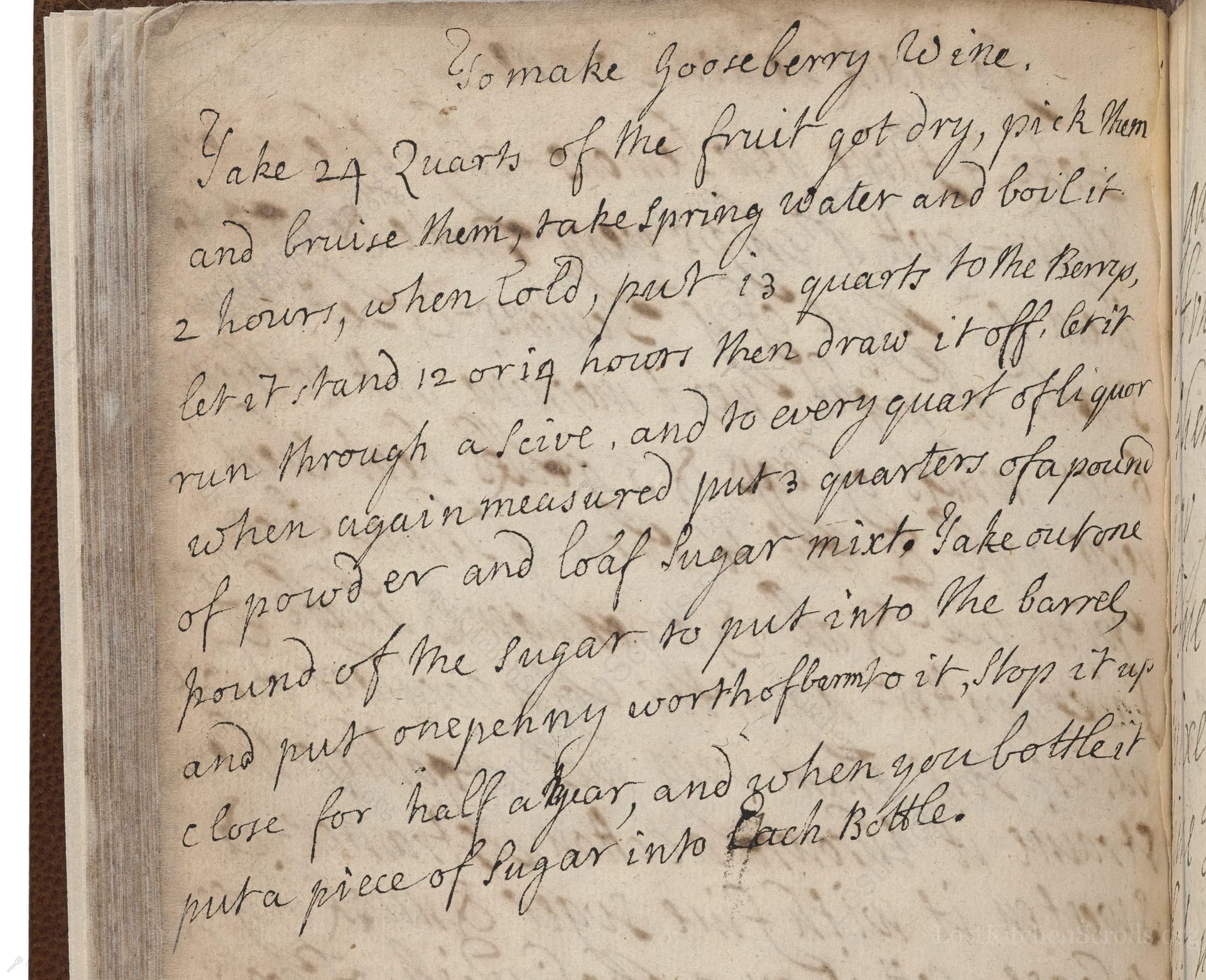To Make Gooseberry Wine
From the treasured pages of Cookery book of Lettice Pudsey, Seisdon, Staffordshire
Written by Lettice Pudsey

To Make Gooseberry Wine
"Take 24 Quarts of the fruit got dry, pick them and bruise them, take spring water and boil it 2 hours, when cold, put 13 quarts to the berrys, let it stand 12 or 14 hours then draw it off. let it run through a seive, and to every quart of liquor when again measured put 3 quarters of a pound of powder and loaf Sugar mixt. Take out one pound of the Sugar to put into the barrel, and put one penny worth of barm to it, stop it up close for half a year, and when you bottle it put a piece of sugar into each bottle."
Note on the Original Text
The recipe is written in the practical, no-nonsense style of the late 17th century, without precise modern measurements or temperatures. 'Quarts' refers to an old volume measure, here replaced by liters. Spelling and capitalisation are erratic by modern standards. 'Powder and loaf Sugar' means whatever forms of sugar were on hand—refined or block sugar. 'Barm' was a common fermenting agent: the frothy head skimmed from beer, which we substitute with dried brewer's yeast. Instructions like 'stop it up close' mean to seal tightly, and the seasonal nature of six months’ aging reflects both necessity and patience.

Title
Cookery book of Lettice Pudsey, Seisdon, Staffordshire (1675)
You can also click the book image above to peruse the original tome
Writer
Lettice Pudsey
Era
1675
Publisher
Unknown
Background
Step into the 17th-century kitchen with Lettice Pudsey's delightful collection of recipes, where flavors, creativity, and tradition mingle to create a feast fit for Restoration-era tables. Expect a medley of hearty English fare, intriguing ingredient combinations, and a pinch of culinary wisdom from a bygone age.
Kindly made available by
Folger Shakespeare Library
This delightful recipe comes from Lettice Pudsey around 1675, a time when domestic wine-making was fashionable amongst English gentry households. Gooseberries, abundant in cottage gardens, were commonly used for home-made wines before grapes became widespread in Britain. This recipe reflects both resourcefulness and the experimental spirit of the period. The process of boiling water, fermenting the juice, and careful bottling reveals an understanding of both preservation and natural fermentation long before modern science caught up.

Back in the 17th century, cooks would use a large cauldron or pot to boil water, heavy mortars or wooden paddles to crush the gooseberries, and linen cloths or fine sieves to strain the liquid. Fermentation would take place in sturdy wooden barrels or stoneware vessels, sealed with wax or wooden stoppers. Bottling was done with thick glass bottles, sealed with cork or cloth tied down with string.
Prep Time
2 hrs
Cook Time
2 hrs
Servings
40
We've done our best to adapt this historical recipe for modern kitchens, but some details may still need refinement. We warmly welcome feedback from fellow cooks and culinary historians — your insights support the entire community!
Ingredients
- 3 gallons gooseberries, fresh and picked clean
- 3.75 gallons spring water
- 21 pounds granulated sugar (substitute for mixed 'powder and loaf' sugar)
- 0.18 ounces active dry yeast or brewer’s yeast (substitute for 'barm')
- Additional sugar cubes, 0.18 ounces per bottle for bottling
Instructions
- Begin with about 3 gallons of gooseberries (fresh, not dried—the original likely refers to berries picked and drained of excess water, not literally dried).
- Pick over the berries to remove stems and leaves, then gently crush them.
- Bring 3.75 gallons of fresh spring water to a rolling boil and simmer for 2 hours.
- When completely cool, add 3.3 gallons of the boiled water to the crushed berries and let the mixture infuze for 12-14 hours, stirring ocassionally.
- Strain off the liquid using a sieve.
- Measure your resulting juice, and for every quart, add 24 ounces of mixed powdered and loaf (granulated) sugar, reserving about 1 pound of sugar to add directly to the barrel during fermentation.
- Stir in about 0.18 ounces of brewer's yeast (as a substitute for 'barm,' the historical term for the frothy yeast from brewing beer).
- Transfer the mixture to a sanitized fermentation vessel, seal tightly, and leave it to ferment for about six months.
- When bottling, add a small piece (about 0.18 ounces) of sugar to each bottle for secondary fermentation.
Estimated Calories
156 per serving
Cooking Estimates
Making this gooseberry wine takes a little preparation, a few hours of cooking, and a long fermentation time. You'll spend some time cleaning and crushing the berries, then boiling water and simmering it. After mixing and infusing, you'll strain and add sugar and yeast. Most of the time will be spent waiting for fermentation, but the hands-on steps are all manageable. These estimates focus on the hands-on prep and cooking, so you know how much time you'll actively spend before fermentation begins.
As noted above, we have made our best effort to translate and adapt this historical recipe for modern kitchens, taking into account ingredients nowadays, cooking techniques, measurements, and so on. However, historical recipes often contain assumptions that require interpretation.
We'd love for anyone to help improve these adaptations. Community contributions are highly welcome. If you have suggestions, corrections, or cooking tips based on your experience with this recipe, please share them below.
Join the Discussion
Rate This Recipe
Dietary Preference
Main Ingredients

Den Bockfisch In Einer Fleisch Suppen Zu Kochen
This recipe hails from a German manuscript cookbook compiled in 1696, a time whe...

Die Grieß Nudlen Zumachen
This recipe comes from a rather mysterious manuscript cookbook, penned anonymous...

Ein Boudain
This recipe comes from an anonymous German-language manuscript cookbook from 169...

Ein Gesaltzen Citroni
This recipe, dating from 1696, comes from an extensive anonymous German cookbook...
Browse our complete collection of time-honored recipes



